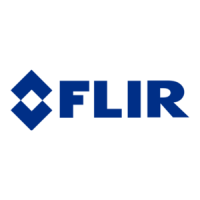16.4.8.4.2 Alternative method using only surface temperatures
There are strong arguments for basing thermographic surveys on surface temperatures
alone, with no need to measure air temperature.
■ Stratification inside the building makes reference to air internal temperatures very
difficult. Is it mean air temperature, low level, high level or temperature at the level
of the anomaly and how far from the wall should it be measured?
■ Radiation effects, such as radiation to the night sky, make use of of external air
temperature difficult. It is not unusual for the outside surface of building fabric to
be below air temperature because of radiation to the sky which may be as low as
–50℃ (–58℉). This can be seen with the naked eye by the fact that dew and frost
often appear on building surfaces even when the air temperature does not drop
below the dewpoint.
■ It should be noted that the concept of U values is based on ‘environmental temper-
atures’ on each side of the structure. This is neglected by many inexperienced
analysts.
■ The two temperatures that are firmly related to the transfer of heat through building
fabric (and any solid) are the surface temperatures on each side.
■ Therefore, by referring to surface temperatures the survey is more repeatable.
■ The surface temperatures used are the averages of surface temperatures on the
same material in an area near the anomaly on the inside and the outside of the
fabric. Together with the temperature of the anomaly, a threshold level can be set
dependent on these temperatures using the critical surface temperature factor.
■ These arguments do not obviate the need for the thermographer to beware of re-
flections of objects at unusual temperatures in the background facing the building
fabric surfaces.
■ The thermographer should also use a comparison between external faces facing
different directions to determine whether there is residual heat from solar gain af-
fecting the external surfaces.
■ External surveys should not be conducted on a surface where T
si
– T
so
on the face
is more than 10% greater than T
si
– T
so
on the north or nearest to north face.
■ For a defect that causes a failure under the 0.75 condition of IP17/01 the critical
surface factors are 0.78 on the inside surface and 0.93 on the outside surface.
The table below shows the internal and external surface temperatures at an anomaly
which would lead to failure under IP17/01. It also shows the deterioration in thermal
insulation that is necessary to cause this.
Failing areaGood areaExample for lightweight built-up cladding with defective
insulation
00Outside temperature in ℃
15.019.1Inside surface temperature in ℃
86 Publ. No. T559580 Rev. a486 – ENGLISH (EN) – November 17, 2010
16 – Introduction to building thermography

